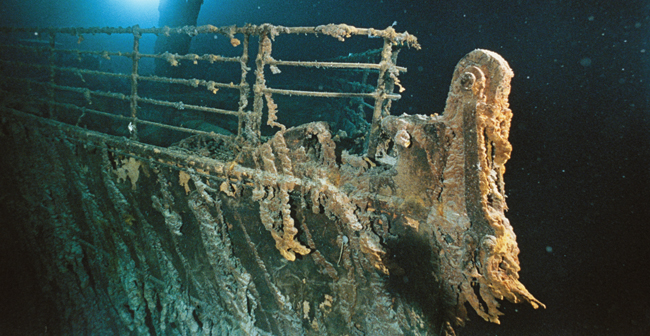Culture
 Photo: Emory Kristof, National Geographic
Photo: Emory Kristof, National Geographic
Untold No Longer: The Story of The Titanic You’ve Never Heard
June 30, 2018 @ 12:00am
We all think we know the story of the Titanic. The world’s largest, most luxurious ocean liner sank in 1912 – a triumph of engineering transformed into unspeakable tragedy.
We now know exactly where she lies, thousands of feet below the surface off the coast of Newfoundland, but the Titanic’s location remained a mystery for 70 years. Then, her story became entwined with a modern narrative of Cold War technology, the tragedy of lost nuclear submarines and a secret mission. This is the haunting, fascinating tale at the heart of the National Geographic Museum’s new exhibit, Titanic: The Untold Story, open daily through early January.
National Geographic Explorer Robert Ballard joined the Army during the Vietnam War, but went to graduate school and got a job building submarines. One December night in 1966, he got a knock at the door from a Naval officer.
“He handed me an envelope and said, ‘You’re not in the Army anymore, you’re in the Navy,’” Ballard told On Tap in a recent interview. “That began a long career of living two different lives.”
To the public, he was a well-known oceanographer, writing articles and researching ocean geology and hydrothermal vents. But Ballard kept working with the Navy and requested funding to develop remotely operated submersibles. The Navy agreed, and assigned Ballard a mission to locate, photograph and study the final resting place of the USS Scorpion, a nuclear submarine that sank in 1968. He was to locate the submarine’s nuclear reactor and nuclear weapons, and to get evidence that would help explain her loss.
There was a problem: it was the height of the Cold War between Russia and the United States, and it was imperative that Ballard’s mission avoid drawing the attention of Soviet intelligence. What better cover story for the mission than a search for the lost wreck of the Titanic?
The Navy added research on one more submarine wreck to Ballard’s plate: the USS Thresher, a nuclear submarine that sank five years before the Scorpion. The scientist was to study both the Scorpion and the Thresher to determine if the nuclear material from both subs was impacting the environment.
Though Ballard already knew what led to the Thresher’s demise, questions about the nuclear material remained. The reason the Scorpion sank, however, was inconclusive. Still, Ballard discovered her location using a phenomenon known as the sound channel.
“There’s a special layer about 1,000 meters down where all sound is ducted. If you listen in the sound channel, you can hear noises much, much further away. And we’re pretty sure that whales figured this out a long, long time ago, and that they use it for long distance communication.”
During the Cold War, the U.S. Navy set up listening arrays in multiple parts of the ocean to detect Soviet activity and recorded whatever sounds they picked up. Ballard said the Navy used these recordings to roughly determine the location of the Scorpion.
“We thought, ‘I wonder if we heard her die?’”
Sure enough, they heard the boom as she imploded in the deep. His towed camera system, the Argo, dove to depths of 9,800 feet to find and document the remains of the Scorpion. He had figured out that ocean currents created a debris trail as the Scorpion sank and followed the trail to the wreck.
He then realized he could use the same strategy to find the Titanic. With the allotted time for his mission nearly up, he found the Titanic at the very edge of the search area. He was awed by what he saw.
“I didn’t expect to be affected by this whole thing,” he said. “I’m a scientist and a naval officer, clinically doing things. But it spoke. I was bowled over by the impact of being there.”
Pairs of shoes litter the ocean floor around the wreck, marking where people who died and sank to the bottom once rested. Because leather shoes are treated with tannic acid, sea life won’t eat them and they remain preserved.
“It’s a tombstone. Nothing is small down there. Everything’s gigantic in size, but then there are these little pairs of shoes. It draws your attention away from the massiveness and the grandeur.”
Ballard noticed them every time he went back.
“Every time I made a return trip, I always knew, I saw those shoes and I said, ‘That was somebody.’”
He recalled returning to the Titanic in 2004 with new vehicles.
“I’m sitting in my command center with a beautiful high-definition camera and a remote control robot, and I’m just staying there. For days, I wandered the Titanic. And I got closure.”
Ballard’s secret mission was quietly declassified just a few years ago. Kathryn Keane, vice president of public experiences for the National Geographic Museum, was amazed to learn that the search for the Titanic was the cover story for Ballard’s mission. National Geographic staff were even on board with Ballard during his mission, and still no one knew.
“I thought to myself, ‘I didn’t know that, and I work here,’” Keane said. “If I don’t know this story, most of the public doesn’t know, either.’”
The new exhibit skillfully blends science, history and storytelling. You begin your visit awed by the technology and the mission’s secret backstory, and end by reading the personal stories of Titanic passengers and viewing amazing recreations of the Titanic’s rooms made for James Cameron’s 1998 film Titanic, which remains one of the most successful films ever made.
It’s a moving experience. Keane noted that this is the 50th anniversary of the sinking of the Scorpion, and the losses of both submarines – the Scorpion and the Thresher – and the “unsinkable ship” have far-reaching effects.
“The layers of tragedy surrounding this story impact generations of people,” she said of the Titanic.
It’s certainly difficult to picture the loved ones of these lost crews and ship passengers waiting in vain for good news without feeling their pain. The last artifact in the exhibit is a letter from President Ronald Reagan, designating the wreck of the Titanic as a memorial site.
And though undeniably one of the most pivotal moments of his career, Ballard isn’t interested in being known solely as the discoverer of the Titanic.
“My mother called me after we found the Titanic and said, ‘It’s too bad you found that rusty old ship.’ She understood hydrothermal vents and the science I was doing, and she said, ‘Now they’re only going to remember you for that.’”
But as Titanic: The Untold Story shows, Ballard’s contributions to ocean exploration are far greater than a single mission in 1985, and the story of these three lost vessels is greater than the sum of its parts. Keane said she hopes the exhibit inspires a generation of new explorers.
“One of the things we love to do here at the museum is invite families and get young people excited about exploration and science,” she said. “The story of the Titanic is why they’ve come, but if they come out of it interested in science, exploration, even in serving their country, that would be a victory for us because that’s what we do here.”
Titanic: The Untold Story runs from 10 a.m. to 6 p.m. daily through January 6, 2019 at the National Geographic Museum. Tickets are $15. And don’t miss the Taste of the Titanic event on Wednesday, July 25 at 7 p.m. to experience the actual menus aboard the ship, from first-class cuisine to third-class nosh. Learn more at http://tasteoftitanic.com/
National Geographic Museum: 1145 17th St. NW, DC; 202-857-7700; www.nationalgeographic.org/dc








